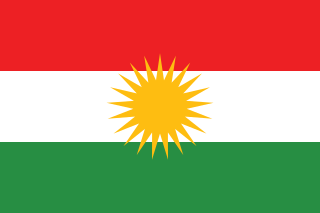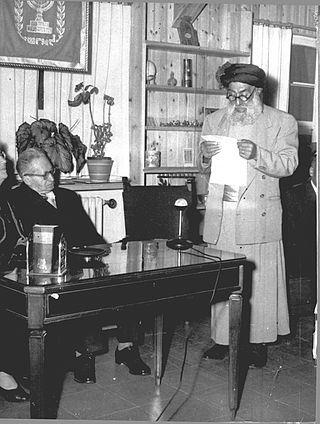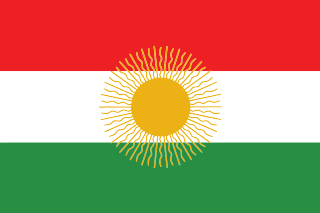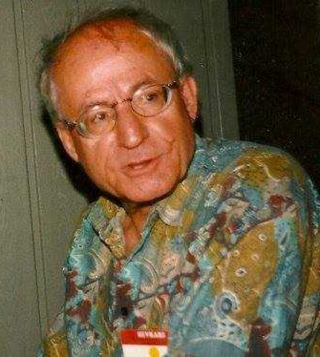Related Research Articles

Kurds or Kurdish people are an Iranic ethnic group native to the mountainous region of Kurdistan in Western Asia, which spans southeastern Turkey, northwestern Iran, northern Iraq, and northern Syria. There are exclaves of Kurds in Central Anatolia, Khorasan, and the Caucasus, as well as significant Kurdish diaspora communities in the cities of western Turkey and Western Europe. The Kurdish population is estimated to be between 30 and 45 million.

Kurdish is a language or a group of languages spoken by Kurds in the geo-cultural region of Kurdistan and the Kurdish diaspora. Kurdish languages constitutes a dialect continuum, many of which are not mutually intelligible, belonging to Western Iranian languages in the Indo-European language family. The main three dialects or languages of Kurdish are Northern Kurdish, Central Kurdish, and Southern Kurdish.

Bedir Khan Beg was the last Kurdish Mîr and mütesellim of the Emirate of Botan.

The Jews of Kurdistan are the Mizrahi Jewish communities from the geographic region of Kurdistan, roughly covering parts of northwestern Iran, northern Iraq, northeastern Syria and southeastern Turkey. Kurdish Jews lived as closed ethnic communities until they were expelled from Arab and Muslim states from the 1940s–1950s onward. The community largely spoke Judeo-Aramaic. As Kurdish Jews natively adhere to Judaism and originate from the Middle East, Mizrahi Hebrew is used for liturgy. Many Kurdish Jews, especially the ones who hail from Iraq, went through a Sephardic Jewish blending during the 18th century.

Dildar, born Yûnis Reûf was a Kurdish poet and political activist, best known for writing the Kurdish national anthem Ey Reqîb.

The Republic of Ararat, or Kurdish Republic of Ararat, was a self-proclaimed Kurdish state from 1927 to 1931. It was located in eastern Turkey, centred on Karaköse Province. "Agirî" is the Kurdish name for Ararat.

Celadet Alî Bedirxan, also known as Mîr Celadet, was a Kurdish diplomat, writer, linguist, journalist and political activist. He held a master's degree in law from Istanbul University, completed his studies in Munich, and spoke several languages including Arabic, Kurdish, Russian, German, Turkish, Persian and French. He left Turkey in 1923 when the Kemalists declared a new republic. In 1927, at a Kurdish conference held in Beirut, a committee was formed, the Xoybûn. He is known for having been the first modern linguist to compile and organise the grammar of the modern form of the Northern Kurdish language, Kurmanji, and having designed the Latin-based Hawar alphabet, which is now the formal alphabet of Kurmanji and is also sometimes used for the other dialects of the Kurdish Language, having replaced the Arabic-based, Cyrillic-based, Persian-based and Armenian-based alphabets formerly used for Kurmanji.

Jamal Nebez was a Kurdish linguist, mathematician, politician, author, translator and writer. He studied Islamic law, philosophy, theology, physics and mathematics at the University of Baghdad in the 1950s. In 1956, he prepared a stenciled script on algebra and in 1960, succeeded in publishing the first physics book in Kurdish, including a rich glossary of Kurdish terms pertaining to physics and mathematics. He translated several literary works, including works of Nikolai Gogol and William Shakespeare into Kurdish. He also wrote and published several books on a variety of topics. Most of the books are mainly about topics related to Kurds.

The Kurdish population of Syria is the country's largest ethnic minority, usually estimated at around 10% of the Syrian population and 5% of the Kurdish population.

Kurdish culture is a group of distinctive cultural traits practiced by Kurdish people. The Kurdish culture is a legacy from ancient peoples who shaped modern Kurds and their society.

Sharaf al-Din Khan b. Shams al-Din b. Sharaf Beg Bedlisi was a Kurdish Emir of Bitlis. He was also a historian, writer and poet. He wrote exclusively in Persian. Born in the Qara Rud village, in central Iran, between Arak and Qom, at a young age he was sent to the Safavids' court and obtained his education there.

The Kurdish population is estimated to be between 30 and 45 million. Most Kurdish people live in Kurdistan, which today is split between Iranian Kurdistan, Iraqi Kurdistan, Turkish Kurdistan, and Syrian Kurdistan.

Doğubayazıt is a town of Ağrı Province of Turkey, near the border with Iran. Its elevation is 1625 m. It is the seat of Doğubayazıt District. Its population is 80,061 (2021). Also known as Kurdava, the town was the capital of the self-declared Republic of Ararat, an independent Kurdish state centered in the Ağrı Province.

Ferdinand Justi was a German linguist and Orientalist.

Kurds in Germany are residents or citizens of Germany of full or partial Kurdish origin. There is a large Kurdish community in Germany. The number of Kurds living in Germany is unknown. Many estimates assume that the number is in the million range. In February 2000, the Federal Government of Germany estimated that approximately 500.000 Kurds lived in Germany at that time.
Kurds in Switzerland are residents in Switzerland of full or partial Kurds origin. The Kurds in Switzerland mainly reside in the Cantons of Zurich, Aargau and Basel-Stadt and are descendants of migrants of refugees from the regions around Pazarcık, Kahraranmaraş or Erzincan. There are also shia kurdish migrants from Iranian Kurdistan, the region around Ilam and Kermanshah along with Feyli Kurds from Baghdad who mainly reside Genève.

Kamuran Ali Bedirxan was a Kurdish politician, lawyer and writer.

During World War I, several Kurdish rebellions took place within the Ottoman Empire.
Ferdinand Hennerbichler is an Austrian historian, philologist, anthropologist, and a prominent Kurdologist. He is also a former diplomat and journalist.
References
- ↑ Scalbert-Yücel, Clémence; Ray, Marie Le (31 December 2006). "Knowledge, ideology and power. Deconstructing Kurdish Studies". European Journal of Turkish Studies. Social Sciences on Contemporary Turkey (5). doi: 10.4000/ejts.777 . hdl: 10036/37913 . ISSN 1773-0546 . Retrieved 21 August 2019.
- 1 2 Alsancakli, Sacha (2016). "The Early History of Kurdish Studies (1787–1901)". Die Welt des Islams. 56 (1): 56. doi:10.1163/15700607-00561p05.
- 1 2 3 4 Alsancakli, Sacha (2016). "The Early History of Kurdish Studies (1787–1901)". Die Welt des Islams. Brill Publishers. 56: 55–88. doi:10.1163/15700607-00561P05.
- ↑ Issawi, Charles Philip; Issawi, Bayard Dodge Professor of Near Eastern Studies Charles (1988). The Fertile Crescent, 1800-1914: A Documentary Economic History. Oxford University Press. ISBN 9780195049510.
- ↑ Kreyenbroek, Philip G.; Sperl, Stefan (2005-08-17). The Kurds: A Contemporary Overview. Routledge. p. 156. ISBN 9781134907663.
- ↑ Campanile, Giuseppe (1818). Storia della regione del Kurdistan e delle sette di religione ivi esistenti del p.m. Giuseppe Campanile professore in sacra teologia, prefetto delle missione della Mesopotamia, e Kurdistan, . (in Italian). dalla stamperia de' fratelli Fernandes. Strada Tribunali, N.° 287.
- 1 2 Kurdologie, Kurdistan und die Kurden in der deutschsprachigen Literatur : kommentierte Bibliographie. Münster: Lit. 2000. ISBN 3-8258-4642-3.
- ↑ "Kurdologie Wien" (in German). Retrieved 11 December 2019.
- ↑ "Iranistik (B.A.) (2-Fächer)" (in German). Retrieved 11 December 2019.
- ↑ "Mustafa Barzani Workplace for Kurdish Studies" (in German). Archived from the original on 11 December 2019. Retrieved 11 December 2019.
- ↑ "Kurdische Sprache und Literatur Beschreibung des Schwerpunkts" (in German). 22 March 2010. Retrieved 11 December 2019.
- 1 2 3 Kemper, Michael; Conermann, Stephan (2011-02-01). The Heritage of Soviet Oriental Studies. Routledge. ISBN 9781136838538.
- 1 2 Bajalan, Djene Rhys; Karimi, Sara Zandi (2017-07-06). Studies in Kurdish History: Empire, Ethnicity and Identity. Taylor & Francis. ISBN 9781317502166.